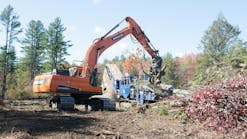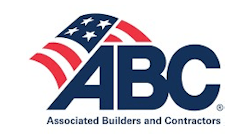The crucially important task of project cost estimating and bidding begins with identifying prospective jobs on which to bid. Once a suitable prospective grading and excavation project has been identified, the next important step is to quickly prepare an accurate cost estimate for carrying out the work defined in the bid documents and then to skillfully mark up that cost estimate to cover overhead expenses and profit-thereby arriving at a bid price that is ideally low enough to win the project but high enough to make a reasonable profit.There are some important issues here:How do grading and excavating contractors and subcontractors track prospective jobs? How do they decide which prospective jobs to pass up and which to bid on? Once they have selected a project to bid on, how do they go about preparing a project cost estimate? Why did they choose the cost-estimating programs they use and what major benefits do they get from using such? Currently, how helpful is the Internet for quickly gathering information (especially product specifications and current prices) on construction products and materials? And given the fact that subcontractors play a dominant role in purchasing, what role is the Internet currently playing-and likely to play in the future-in the actual purchase of construction products and materials?To get at these and other important questions centering on project cost estimating and bidding, we turn now to three in-depth case histories with grading and excavating contractors and to two sidebar interviews. One interview is with a leading producer of cost-estimating software, and the other is with a leading provider of Internet-based services (including dissemination of forthcoming project plans and specs and an online construction products and materials catalog) for contractors and subcontractors.Cost-Estimating Advances at a Midsize Alabama Contractor One midsize grading and excavating contractor that has been modernizing its approach to cost estimating and bidding is Waters Brothers Construction in Decatur, AL. According to Vice President Rodney Terry, the firm does about $20 million/yr. of site development work (including clearing, grading, installation of utility lines, and paving) and highway grading and paving, operating mainly in northern Alabama. About 30% of this contractor’s work is in the public sector, and the remaining 70% is in the commercial and industrial sectors. Waters Brothers also owns and operates a quarry that produces sand and gravel, the output of which is sold to paving contractors, ready-mix plants, and concrete-pipe plants.The job estimating and bidding process of course begins with deciding on which job to bid. To keep on top of prospective projects in northern Alabama, Waters Brothers subscribes to an information service called Construction Datafax in Montevallo, AL. This service posts advertisements for bids from state, county, municipal, and other public agencies in Alabama, Mississippi, and the Florida Panhandle. This service sends several sheets of updates via fax daily. Terry estimates that about 20% of his company’s prospective project leads come from this source. The other 80% of job leads, he believes, come in as a result of the firm’s well-established reputation as a grading, site development, and paving contractor. Major private developers of shopping centers, industrial and commercial general contractors, and other companies in the private sector frequently invite Waters Brothers to bid on upcoming projects.Waters Brothers is also finding the Internet very useful in searching for work. For instance, the Alabama Department of Highways now regularly posts on its Internet site on the first day of every month its advertisements for bids. Terry says Waters Brothers regularly scrolls through these items, confining its interest to prospective projects in northern Alabama; there is enough work in this region to keep the firm plenty busy without the need to go farther afield.Terry believes that, in the near future, many of the large developers in Alabama will create Internet sites and, among other things, list their advertisements for bids (currently, few developers in Alabama have Web sites). Once that is the case, Waters Brothers plans to regularly scan these Web sites for leads.Reflecting on his experience in the construction industry over the past 15 years, Terry explains that the company has made some major changes in the way it estimates and bids jobs. Terry learned the business of being a grading and excavating contractor from his father, who headed a firm called Larry Terry Contractors. Terry says that, back in the 1980s, it was fairly common for his father’s estimating department to spend three or four weeks, using hand calculation methods, to put together a cost estimate for a major project. At that time, the people in the estimating department often worked 12 hours a day, six days per week. Using project drawings and maps dealing with, for instance, a proposed highway project, estimators had to determine what cuts and fills would have to be made on a project, how many tons of earth would have to be moved from location A to location B, what average haul distances would be, what haul-road conditions would be like (e.g., how steep), what equipment would have to be used, the equipment and manpower makeup of construction crews, and so on. The Main Benefits of PC-Based Cost EstimatingBut this labored approach to cost estimating began to change quite radically in 1990, when Rodney Terry bought an IBM-compatible PC, Hard Dollar’s cost-estimating software, and take-off software made by Agtek Corporation. At the time, Terry himself was quite inexperienced in the use of computer software. Yet by carefully studying the accompanying software manuals, he was quickly able to learn the ins and outs of the programs. And software-support technical assistance was readily available from both Hard Dollar and Agtek for problems he could not solve on his own.Today Terry continues to use an updated version of these original software packages. The upshot is that Waters Brothers can now produce project cost estimates that are considerably more accurate and do it much faster than before-in some cases as much as 20 times faster. Terry says that three people in the estimating department can now do the work that once required 20. As a consequence, the company is bidding on far more jobs-triple what it did a decade ago, prior to the use of cost-estimating software.Terry believes that most medium-size contractors in Alabama are currently using some sort of cost-estimating software and that even small contractors could greatly benefit from the using it.What are the features of this cost-estimating software that Terry finds most beneficial? The biggest advantage, he says, is being able to use your cost database over and over again from one project to another. Terry has stored in his PC all his cost estimates for the past decade. To do a cost estimate for a new project, he merely retrieves a computer file of a cost estimate for a similar past job, then proceeds to update various cost parameters such as fuel costs, labor costs, and equipment rental rates. It is a matter of fine-tuning the old estimate to meet the conditions of the present project, notes Terry.He says another major advantage of the Hard Dollar cost-estimating software is the fact that it is compatible with the related Hard Dollar project management software. That is, all the planning and data created during the cost-estimating phase can now be transferred to the project management software. Thus, once Terry has cost-estimated a project, submitted a bid based on that estimate, and won the bid, he does not have to go back to square one in managing the actual construction project. All the planning and data embodied in the Hard Dollar Estimating Office System program can now be readily transferred to a Hard Dollar project management program. This program can now be used to track carefully budgeted dollars for certain project tasks against actual construction costs in the field. Further, that project management program can be used for a wide variety of project management tasks, including the recording of meeting minutes and the preparation of contracts, change orders, and purchase orders (see “Computerized Project Management Jumps to the Internet” in the September/October 2000 issue).Cost estimating for Rodney Terry and Waters Brothers has changed dramatically over the past decade, as they have moved from hand calculation and PC-based spreadsheet programs to more sophisticated PC-based cost-estimating software. Computerized cost estimating has enabled them to do cost estimates up to 20 times faster compared to hand calculation. They now bid three times the number of jobs they did a decade ago, in large measure because of their ability to quickly grind out cost estimates and bids. Whereas in the past it might have taken two to three weeks to do a cost estimate on a major project, they can now do a cost estimate-if necessary-in a few days. This gives them the capability to bid on a project they hear about at the last minute, only a few days before bid opening. A big advantage of the software Waters Brothers uses for cost-estimating is not needing to continually reinvent the wheel: Much of the planning and cost data developed for past jobs are transferable to current jobs, and all of the planning and data developed during the cost estimating and bidding phase are readily transferable to the project management phase-if the project is won.
Internet Will Further Speed Up Cost Estimating This is not the end of the road, as Terry sees it, for advances in the science and art of job cost estimating. Over the next several years, the Internet will considerably speed up and make less tedious the task of cost estimating. Instead of having to plow through suppliers’ catalogs and make numerous phone calls, the contractor or subcontractor estimator will be able to connect via the Internet to a supplier’s Web site and research from any place at any time product specifications and price information. Or the contractor or subcontractor will be able to tap into Internet-based catalogs put together by third parties such as Build Point (see sidebar). Here he or she will be able to quickly pinpoint relevant suppliers in a geographical area and quickly view product specifications and prices from such suppliers, as well as order products on-line. Terry believes the Internet will help Waters Brothers improve the speed and accuracy of its project cost estimates. Specifically, in the near future, he expects to be able to visit the Internet Web sites of relevant product and materials suppliers to get instantaneous access to product specifications and prices. For his projects, Terry typically has to buy such items as concrete pipe for storm drains, sewer pipe, water mains, aggregate, and filter fabric. “Right now,” Terry explains, “though we may have a supplier’s catalog, we do nonetheless often have to phone the supplier to get current information on price, availability, etc. It would be much more convenient if we could access the supplier’s Internet site to retrieve updated product information and prices-especially when trying to crash out a project cost estimate late at night or on a weekend to meet a tight deadline for a bid opening. Currently, very few construction-products and materials suppliers in Alabama have Internet sites. But I would very much like to see most suppliers launch such Internet sites during the next year. It would be a tremendous help-not only to our company but to any contractor or subcontractor-to be able to access a supplier’s Web site, double-click on a product, then quickly be able to view specifications and list price.”In summary, Terry is quite receptive to the idea of using the Internet for gathering information concerning product specifications and price-whether it be off a supplier’s Web site or a third-party Internet-based catalog like that of Build Point. How aggressively contractors and subcontractors will actually purchase products and materials via the Internet should begin to become clear over the next few years.Advances in Cost Estimating at Another Midsize ContractorBeyer Construction is a $22 million/yr. grading and paving contractor based in Houston, TX. Much of its work is the grading and paving of concrete roads for private commercial developments, residential subdivisions, and municipal, county, and state governments. Its focus is on concrete paving; the company avoids asphaltic-concrete paving because of the high cost of asphalt. It also tends to avoid interstate highway work because of high-liability exposure and troublesome traffic-control problems.Once again, the task of job cost estimating begins with identifying prospective projects on which to bid. How does Beyer track prospective projects? According to estimator Jim Thompson, Beyer uses an information service called Amtek. That company operates an Internet site that posts advertisements for bids from public agencies in the Houston, Dallas, and San Antonio areas. Beyer has been using this service for four years now. With this service, the company finds it easier to track prospective jobs than using its former method of scanning through numerous daily and weekly newspapers to uncover advertisements for bids. Dodge Reports and the Association of General Contractors also have plan rooms that Beyer has visited from time to time to examine plans and specifications for jobs on which it was planning to bid. Beyer scans through the advertisements for bids on the Amtek Internet site and identifies those projects it wishes to bid on, avoiding any projects calling for asphalt paving. Then it calls upon the relevant government agency or consulting firm in the Houston area to pick up a copy of plans and specifications for the project of interest. More recently Amtek has had the plans and specs for many projects posted on its Internet site, so Beyer now has the option of obtaining a particular job’s plans and specs by downloading them from Amtek’s Internet site.Thompson says most public agencies in Texas begin advertising for bids 30 days before the bid deadline. And this is plenty of time, for it usually takes Beyer only one to 10 days to ready a bid proposal.Deciding Which Jobs to Bid OnHow does Beyer decide on what jobs to pass up and which to bid on? Similar to some other contractors, Beyer will sometimes bid on a project that is not on its “top-priority” list. On such projects, it will bid with a higher profit markup than for projects that are on its top-priority list. Why bother to bid on such projects at all? Because, explains Thompson, many other contractors may also put the project on their “low-priority” list and decided not to bid; if so, Beyer might end up getting the job-earning a higher profit margin than with the jobs it wins on its top-priority list. Also, Beyer sometimes bids on low-priority projects just to keep in touch with the marketplace and keep abreast of what competitive prices are.Beyer screens out all projects that exclude reinforced concrete pavement. And it often passes on projects that are highly competitive, where too many paving contractors are competing for the project. (A company can usually find out from the public agency how many contractors are planning to bid.) “We have a much better chance of winning on a project where only five contractors are bidding than on one where 20 are bidding,” explains Thompson.Overall, Beyer bids on about 15 public-sector projects per month (ranging in size from $80,000 up to $10 million), perhaps winning 30-40% of these, Thompson guesses. Yet 70% of Beyer’s work comes from housing developers and other private-sector clients. And in the private sector, the work is usually secured not by competitive bidding, but by negotiation with a client for whom the company has done work in the past.Beyer Does Its Own Cost EstimatingFor much of the 1990s, Beyer Construction used PC-based Lotus spreadsheets for working up job cost estimates. In working up the cost estimate for a new project, it would begin with the spreadsheet from a previous, similar project and make appropriate adjustments to tailor it to the present job. One of the frustrations of using this spreadsheet approach, Thompson recalls, was that the user would often accidentally type a number into a cell containing a formula, thereby annihilating the formula and forcing the estimator to re-create the spreadsheet all over again.In late 1998, Beyer purchased Hard Dollar’s Estimating Office System software. The upshot of using this cost-estimating software is that it has substantially reduced the tedium and time of working up a cost estimate. Whereas in the past it took two-and-a-half to three hours to do an estimate with a spreadsheet for a typical paving project, that time, Thompson guesses, has now been cut to between one and one-and-a-half hours-an average time reduction of 50-60%. This greater cost-estimating efficiency means that Beyer has been able to boost the number of jobs on which it bids by about 10%.One thing that Thompson especially likes about the Hard Dollar estimating software is the way all the basic cost information gathered on a previous job can be reused on a new job. He is able to create a master folder into which he places basic cost data-on equipment, construction products and materials, labor, workers’ compensation, insurance, and so on. If there have been any basic changes in these costs for the current job versus previous jobs, he can quickly update these costs in the master folder-and these changes will be automatically carried through all other components of the Hard Dollar software. Said another way, once Thompson builds up a cost estimate for a particular work task-for example, paving 6-in.-thick reinforced concrete pavement in a housing subdivision using steel formwork (in recent years Beyer has been using mainly steel forms because they last much longer than wood forms, wood forms being used now mainly on curves)-he can reuse that work module for his next project. Of course, he will have to fine-tune the estimate to meet the circumstances of the new project-adjusting hourly labor rates, crew production rates, and equipment costs (soils on the current project might be more abrasive to equipment than on a previous project).Thompson believes that most contractors today are using computer-based methods to work up bid prices. Yet many, he says, are still using spreadsheets as distinct from more sophisticated cost-estimating software. Among other cost-estimating software that Beyer looked at before settling on the Hard Dollar software were those marketed by HCSS and Timberline.To quickly recap the benefits of using this cost-estimating software over the previous spreadsheet approach at Beyer: (1) Working up cost estimates is 50-60% faster, typically taking one to one-and-a-half hours rather than two-and-a-half to three hours; (2) the greater speed enables Beyer to bid on 10% more projects; (3) the software is easier to use and reduces tedium; and (4) the cost-estimating program readily meshes with Hard Dollar accounting and project management programs, ensuring that all the planning and cost estimates done at the bidding stage do not have to be repeated during the project management phase. Marking Up the Cost Estimate to Arrive at a Bid PriceOnce Beyer has come up with a job cost estimate, it then marks up that cost to arrive at a bid price. The first step in doing that is to cover all appropriate overhead costs-costs associated with its office operations, other buildings and equipment maintenance facilities, bond costs, construction insurance, general liability insurance, workers’ compensation, and so on.To arrive at the actual bid price for a particular job, Beyer, like other construction companies, adds two markups to the job cost estimate: markup # 1 is for covering overhead costs; markup # 2 is to provide for a fair profit. As a rule of thumb, on a very competitive project (e.g., 20 other contractors bidding), Thompson says he would use a low percentage for profit markup. On a less competitive project, however (e.g., two to four other bidders), he would risk a higher percentage markup for profit while still hoping to have a low-enough bid price to win the job.Beyer’s Thompson is very guarded about company cost information-how much it is paying for equipment, materials, labor, insurance of different kinds, and so on. This is critical information that Beyer dreads falling into the hands of a competitor. Says Thompson: “Not every contractor has the same costs. If a competitor gets a hold of my cost data and is able to see my costs for equipment, materials, labor, insurance, et cetera, that could hurt us a great deal. He would know what we would likely be bidding on future jobs and then be able to consistently underbid us. Many people are currently talking about sending job-bidding information across the Internet, subcontractors transmitting job bid price data to GCs and owners. But for security reasons I would be extremely reluctant to do so, especially on public-sector jobs requiring a detailed breakdown of costs for various components of a job.” Yet, as an alert estimator, Thompson is himself very eager to learn all he can about the cost databases of competitors. To that end, he spends considerable time studying how competitors bid on jobs. And by comparing a competitor’s bid price on one job (which may have 10 job components) with a subsequent job (which may have the same 10 components plus another two), he can begin to understand what the competitor’s costs and markups might be with respect to those two new components. The information that comes out of the analysis of a competitor’s bidding prices is very useful to Beyer in bidding on future jobs.The Small-Contractor ApproachEarth Construction is a small ($2.5 million/yr.) grading and excavation contractor based in Fort Wayne, IN. Operating mainly within a 100-mi. radius of Fort Wayne, the company is involved mainly in the laying of water and sewer lines, in industrial and commercial site development, and in the grading and paving of roads and highways.How does Earth Construction locate prospective jobs on which to bid? Similar to most other construction companies, explains the firm’s Michael Evertson, Earth Construction scans local newspapers covering the 100-mi. radius around Fort Wayne for advertisements for bids from municipalities and other public agencies as well as solicitations from private owners and developers. In addition, public agencies, owners, and consulting engineering firms will send solicitations to Earth Construction to bid on forthcoming projects. The company also reads Dodge Reports.How useful would Earth Construction find the huge Internet-based databases of bid solicitations that some Internet companies are now offering? Evertson says such a service would not be all that useful to a company such as Earth Construction because its focus is very local. They get all the information they need from the sources mentioned above-local newspapers, owners, consulting engineers, and Dodge Reports. Evertson believes these large Internet-based services posting solicitations are more suitable for large construction companies that operate over a much wider geographical region.Doing the Cost Estimate ItselfOnce Earth Construction has scanned through the advertisements for bids and selected the relevant projects in its territory, it moves on to the business of estimating costs on a particular project. According to Evertson, Earth Construction has been using computers to help work up cost estimates since the early 1980s, when it purchased its first personal computer and began to use spreadsheet programs such as Lotus and VisiCalc. By the mid-1980s, Earth Construction was using its first cost-estimating software, a so-called earthwork-takeoff package produced by Agtek. By the late 1980s, it was using Hard Dollar’s cost-estimating program called Estimating Office System.In working up a cost estimate for a typical site development project to construct a shopping center, office park, or housing development, Earth Construction has to come up with unit cost estimates (e.g., so many dollars per foot of sewer line installed) for these job items: site clearing and demolition; stripping away topsoil; site grading, including all cuts and fills; compacting of fill; installation of storm and sanitary sewers (in sizes ranging from 6 to 60 in. in diameter); installation of sewage lift stations; and installation of water-distribution systems.The end result is a total project cost calculated from a long list of unit costs. But the unit costs do vary from project to project, depending on the site location, the terrain, the soil conditions, the depth to which the pipe must be laid, and so on. The cost of site grading also varies from job to job, depending on how much earth has to be moved and how far it has to be hauled. Crew production rates (so many feet of sewer pipe laid per hour) are also going to vary, depending on site conditions.Nonetheless, Evertson points out, there are certain things that remain relatively constant from job to job: the crew size and equipment for laying pipe, certain material costs, and so on. The software enables these constants to be preserved from job to job so estimators are not constantly reinventing the wheel. Estimators can fine-tune the various unit cost estimates from a previous similar job to meet the circumstances of the present job. With that done, it is an easy matter for the cost-estimating software to now quickly calculate the total cost for various components of the job and for the total job cost.Evertson says that using PC-based cost-estimating software has enabled Earth Construction to do cost estimates in one-quarter the time it used to take it years ago when it was still using hand methods. How Does the Internet Figure Into Cost Estimating and Purchasing?Currently, Evertson says Earth Construction is finding the Internet useful in cost estimating by looking up the Web sites of various suppliers to get useful information on product and material specifications and for price information.On what kinds of products and materials does Earth Construction need to get price quotes for cost estimating-and later for purchasing once it has won the contract for a project? Here are the most typical items it orders: water pumps, manhole covers, water pipe, sewer pipe, pipe fittings, valves, fire hydrants, catch basins, soil, aggregate, backfill materials, concrete-reinforcing steel, French drains, filter fabrics, grass seed, and erosion control materials.Nonetheless, Evertson still gets most of his hard price quotes by first faxing several suppliers of a given construction product or material a list of the items and the quantities desired. The supplier then faxes back a quotation for the total cost of the materials in the quantities desired delivered to the actual job site. Often the supplier will quote his numbers in terms of unit price (e.g., so many dollars per foot of 12-in. ductile iron pipe delivered to the job site). The upshot here is that Earth Construction is finding the Internet useful in doing cost estimating because it enables instant access to supplier Web sites for information on products and prices. But it is clear that much business is still done the old-fashioned way, by phone and fax, to get firm price quotes from suppliers. What is the likelihood that, in the near future, Earth Construction will be purchasing construction products and materials via Internet sites with online catalogs such as Build Point? From his current perspective on things, Evertson does not believe such Internet construction-product sites will change the traditional way the company purchases.“We are very wedded to local suppliers, those within about a 25-mile radius of Fort Wayne,” explains Evertson. “On a typical construction project, we encounter many changes and we may have to send materials back to the supplier and have them quickly replaced with a different size or material. Maintaining such flexibility requires that suppliers be local to the area that we are operating in.”This critical need for flexibility was underscored on a recent Earth Construction project. The company contracted to tap into an existing buried, 10-in. water main and to run a new 10-in. water line off that main. A local supplier delivered 10-in. water pipe to the site for the proje








